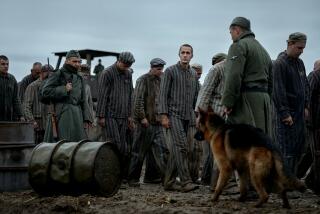‘America in the ‘40s’ Skims Lightly Over a Rich Decade
- Share via
What that fine Canadian documentary, “The Fifties,” achieved in eight hours on the History Channel last year, “America in the ‘40s” doesn’t come close to matching in three on PBS tonight.
Not that the decade dominated by World War II is less compelling as history, only that the unnarrated 180 minutes--driven by vintage music, movie clips and mostly lilting personal anecdotes--are hardly sufficient for a period that had such a profound influence on the course of humankind, even when hosted by that quality actor, Charles Durning. It’s like trying to cross the Atlantic or Pacific on a footbridge or trying to accommodate a panoramic sunset through a keyhole.
Tom Spain’s documentary is pleasing, entertaining and at times quite moving, as when recording battle-scarred GIs’ awkward readjustment to civilian life and the painful, ever-enduring residue of war. There is the great World War II cartoonist Bill Mauldin, for example, choked with emotion while recalling an especially meaningful Memorial Day ceremony: “I don’t wanna hear another Memorial Day speech. . . . I wanna quit with that memory.”
Through some of the period music and flashbacks from a handful of Americans who lived through the ‘40s, Spain also touches on the anomaly of an age that, in memory at least, seems somehow as romantic as it was grotesque. And there’s old newsreel footage here capturing a postwar jubilation--much like Times Square on New Year’s Eve--of the sort Americans have not experienced after any military conflict since.
Yet “America in the ‘40s” is extremely thin, lacking context, cohesion and a strong, all-inclusive narrative as it zooms across the decade, leaving behind gaping holes in its storytelling.
Early in the film, the president is Franklin Delano Roosevelt. When the decade ends, it’s Harry Truman. No explanation. The U.S. internment of Japanese Americans is unmentioned, moreover, and the Holocaust is allotted only a few flickering images. Even more troubling is that the America here is almost exclusively white America. The rare exception is a black former GI who, late in the film, recalls being greeted by his dog when returning from the war, a memory that the documentary illustrates with a movie clip of a white vet being greeted by a dog.
The unintended message is that movies virtually ignored blacks’ contribution to the war effort, a metaphor for racism that “America in the ‘40s” doesn’t bother to decode. Call this the short course.
* “America in the ‘40s” airs at 8 tonight on KCET-TV Channel 28.
More to Read
Only good movies
Get the Indie Focus newsletter, Mark Olsen's weekly guide to the world of cinema.
You may occasionally receive promotional content from the Los Angeles Times.










